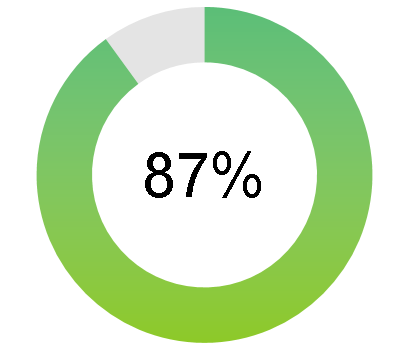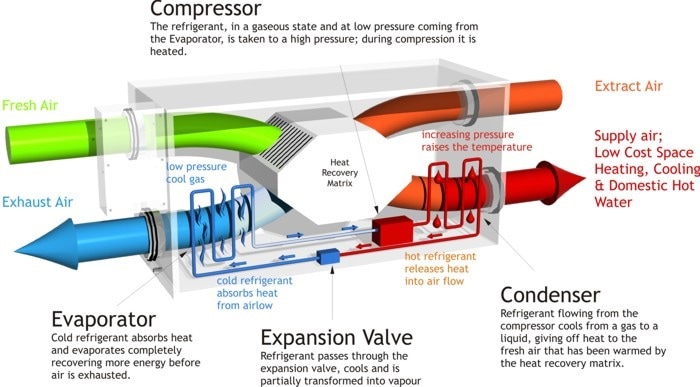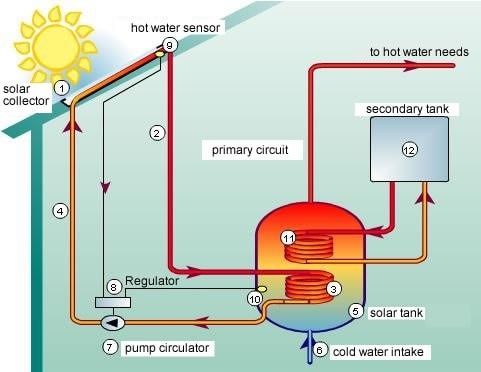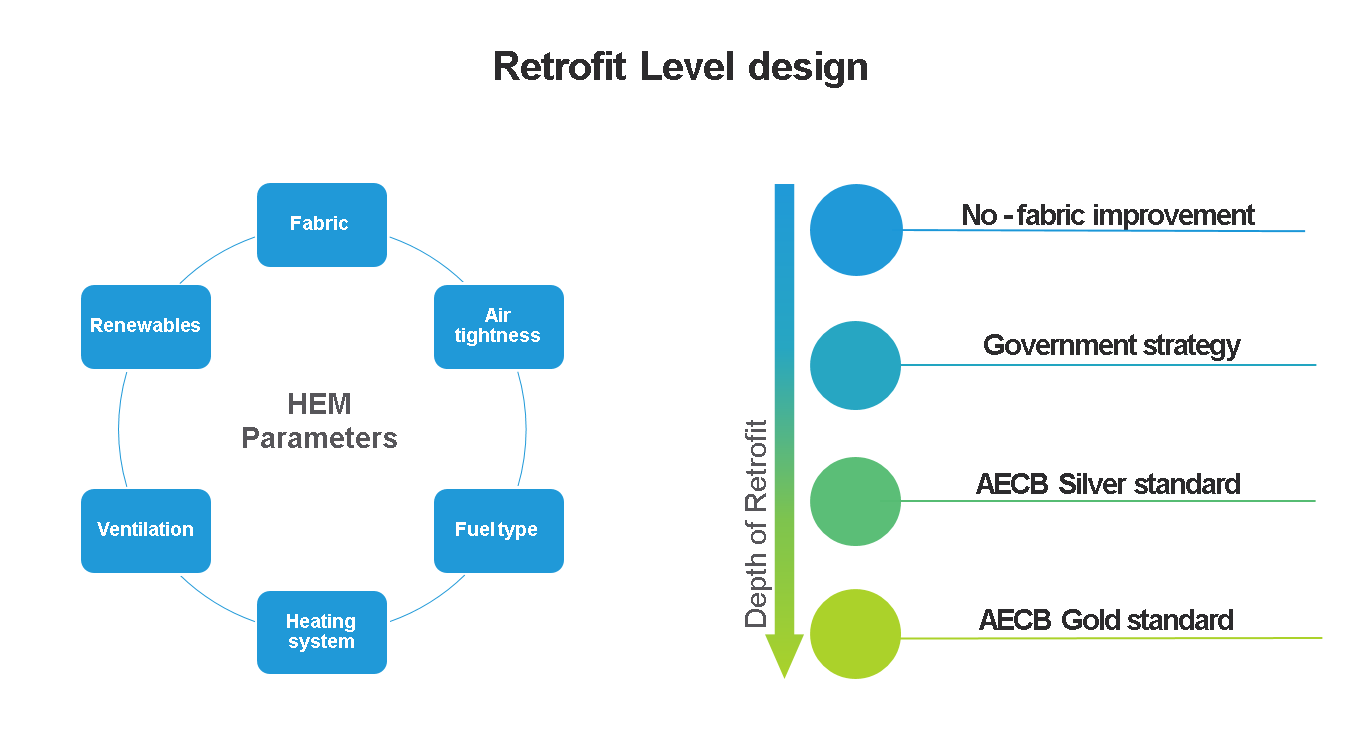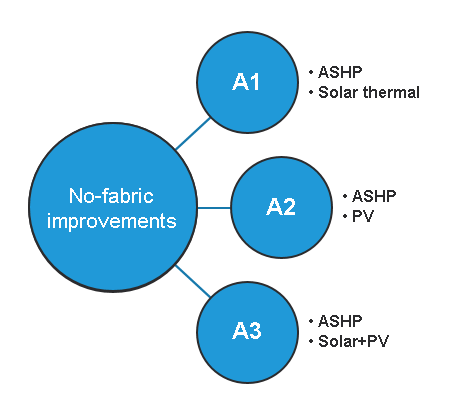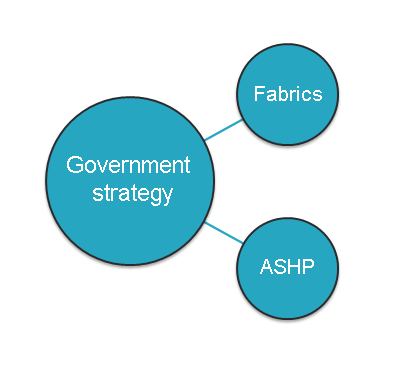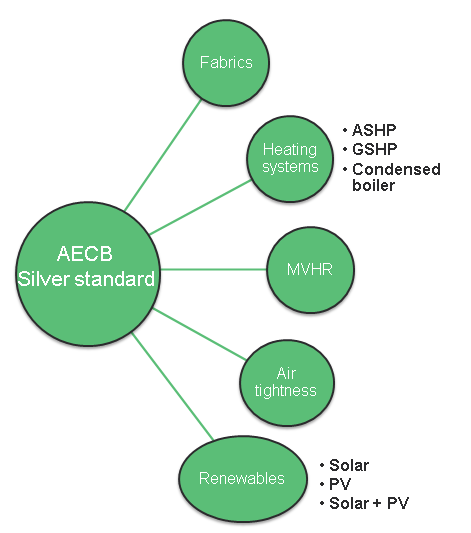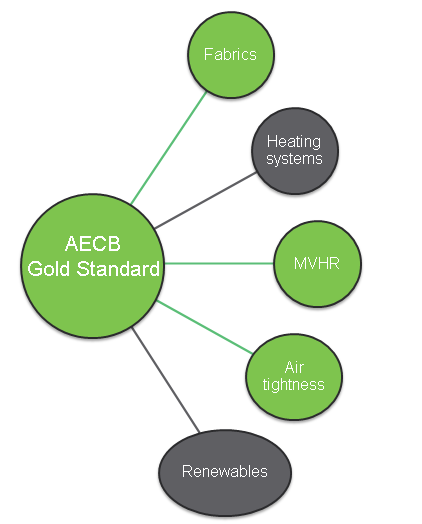Defining Retrofit Levels
We defined a variety of retrofit levels based on existing projects within the UK, covering aspects including fabrics, ventilation systems, air tightness, heating systems and renewables.
Fabrics
This covers any advanced improvements to the fabric of the building, including adding cavity insulation to walls, loft insulation to roofs, increasing window glazing, and even adding insulation to the floor.
Heating Systems
|
Statistics show that 87% of household energy demand is derived from heat. This is split between space heating (74%) and water heating (13%). As a result, addressing these demands can be one of the most effective methods of reducing energy consumption. There are many ways of heating buildings, but for the purposes of our research, we focused on heat pumps and gas boilers.
Heat Pumps
Heat pumps use electricity to provide heat with extremely high efficiencies and are considered a form of low carbon heat. Both air source (ASHP) and ground source heat pumps (GSHP) were both considered in this study. Gas Boilers Gas boilers use mains gas often sourced from non-renewable sources. The types considered here were condensing boilers, which are common and are almost 100% efficient. |
Ventilation SystemsA considerable amount of energy is lost in a building as a result of air permeating through the building fabric. This can be combatted by improving the air tightness of a building through the use of an air-tight membrane. This can cause with issues with indoor air quality, so a ventilation strategy is required. There are several ways of doing this, and for this project we considered mechanical ventilation heat recovery (MVHR) systems, taking into account varying performance efficiencies. MVHR works by extracting stale warm air from a building, then passing this through a heat exchanger to recover heat which is then circulated throughout the dwelling.
|
Renewables
|
Renewables play a key part in any sustainable energy system, and there are ways to integrate renewable with buildings on a small scale. Most commonly found on buildings are solar technologies. For this project we considered solar thermal water heating and photovoltaics (PV).
Solar Thermal Water Heating
This is where a solar collector absorbs heat from the sun, and stores it in a water tank for domestic hot water needs. The HEM parameter that was selected for all applications of this was 4 m2 of flat plate collector. Photovoltaics (PV) This is where solar panels convert light shining on them into electricity, and the electricity can feed the demands within the household, or be exported to the electricity grid. The HEM parameter selected for applications of this was 8 m2 of monocrystalline PV. |
Retrofit Decision Making
Based on previous retrofit projects and standards exemplified throughout the UK, and considering the depth variation and environmental impacts, four retrofit categories were generated: no-fabric improvement with renewables, the Government strategy, and two deep retrofits based on the AECB silver and gold standards. Exact details of all retrofit levels can be found in our HEM modelling input spreadsheet.
No-fabric Improvement
|
This category was created with the intention of investigating the effect of applying renewables to a property without applying any fabric improvements. These retrofits all run on electricity, and are fitted with an air-source heat pump, along with varying levels of solar renewables, resulting in a total of 3 different retrofit levels:
|
Government Strategy
|
As part of the Draft Climate Change Plan, the Scottish Government is including extensive deployment of moderate retrofit measures to the residential building stock. As part of this strategy, the Scottish Energy Efficiency Plan (SEEP) has been developed with the aims of:
Building Fabric The Government strategy for fabric improvements provides a recommended minimum of:
Improvements in windows were also considered here as they are a common retrofit measure. Using a paper that assessed the U-values of existing Scottish buildings, we were able to specify the fabrics improvements required by the Government:
Using this information, we developed an equivocal retrofit level that could translate to the HEM parameters. This was using an air-source heat pump with electricity as a fuel type, and the above U-values. This was further split into two levels to represent pre-1919 buildings, where no cavity wall was selected for simplicity; and post-1919 buildings, where a cavity wall was selected. |
AECB Silver & Gold

Following the previously described shallow retrofit categories, the next step was to look at deeper retrofit measures. For this we wanted to choose a standard that already existed within the UK. We have selected the Silver and Gold standards defined by The Association for Environmentally Conscious Building (AECB), which is an organisation within the UK that aims to promote sustainable building. The image below shows the three energy standards that were developed in 2007 and the energy & CO2 targets per dwelling. Since then, the Passivhaus and Gold standards have merged to form the same standard.
|
AECB Silver
The Silver standard is a considerably deeper retrofit that the two categories previously defined. In total, 6 levels of retrofit were created based on this standard, with 5 running on electricity, and 1 gas-fuelled level that was modelled with the intention of observing the effects of deep retrofit measures applied to gas heating systems. In terms of fabrics, much lower U-values were applied to buildings, including floor insulation. Every electrically-fuelled retrofit level has a heat pump, with 1 level having a ground-source heat pump (GSHP). Every level has tighter air changes, set at 'Standard' on HEM, and features a high-efficiency MVHR unit. The latter 3 levels have the same renewables applied to them as the no-fabric improvement retrofit category. |
|
AECB Gold
The Gold standard features the deepest level of retrofit that was used in this project, and frequently takes the HEM parameters to the maximum level of retrofit. 4 levels of retrofit were created based on this standard, and similar to our silver levels, 1 was based on gas to observe the effects of the relationship between gas and deep retrofit. The remaining 3 standards were electrically-fuelled. Regarding fabric inputs, the lowest U-values available in the HEM software are applied here. Similar to silver, 1 electric system has a GSHP and the remaining 2 have an ASHP. The air changes are set to 'Tight', and each level is equipped with a super-efficient MVHR unit. Every level has solar thermal water heating as is a requirement for the Gold/Passivhaus standard, and the 4th level has added PV. |
